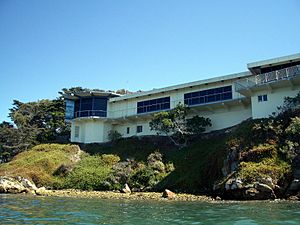Morro Bay State Park Museum of Natural History facts for kids

Morro Bay Museum of Natural History, overlooking the Morro Bay estuary
|
|
| Established | 1962 |
|---|---|
| Location | 60 State Park Rd Morro Bay, California |
| Type | Natural history museum |
The Morro Bay State Park Museum of Natural History is a fantastic place to explore the natural world! It's a special kind of museum called a natural history museum. You can find it inside Morro Bay State Park in Morro Bay, California, in the United States. This museum first opened its doors in 1962.
Contents
Discovering Morro Bay's Nature
The museum is built on a hill. From here, you get an amazing view of the Morro Bay estuary. An estuary is a unique place where a river meets the ocean. This mix of fresh and salt water creates a special home for many plants and animals. The museum is located about halfway between the big cities of Los Angeles and San Francisco. You can also see the famous Morro Rock from the museum.
A Unique Museum
This museum is very special because it's the only natural history museum in the entire California State Park system. This means it's a one-of-a-kind spot to learn about nature within California's beautiful state parks.
Modern Exhibits and Fun Learning
The museum got a big makeover between 1993 and 2002. This project updated the museum in three main steps. New exhibits were created by a company called Exhibitgroup Giltspur. This company has also designed exhibits for famous places like the Smithsonian and J. Paul Getty museums.
The displays at Morro Bay are very interactive. This means you can touch, push, and play with them to learn! These exhibits teach you all about the ecology of the Morro Bay estuary. Ecology is the study of how living things interact with each other and their environment.
Interactive Learning Stations
Some of the fun things you can do include:
- Building a sand dune: Learn how sand dunes form and why they are important.
- Operating the hydrologic cycle: See how water moves through the environment, from rain to rivers and back again.
- Creating food chains: Discover how different plants and animals depend on each other for food.
These hands-on activities make learning about nature exciting and memorable for everyone.

